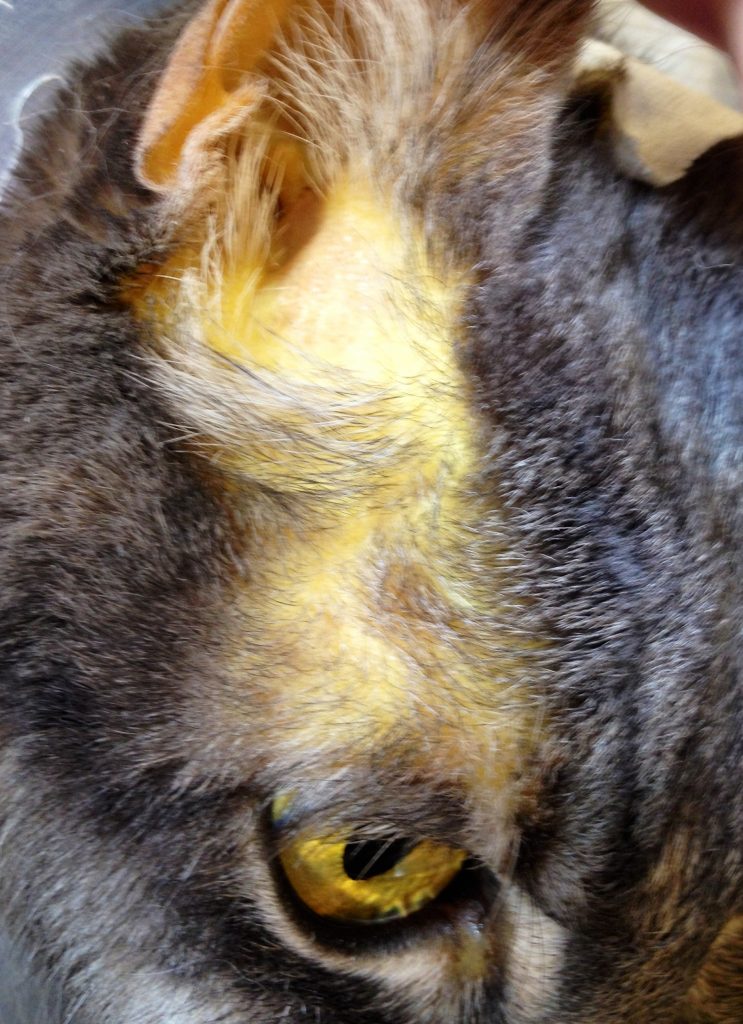Attentive pet parents perpetually look over the pets for signs of problems. Does their pet have any new lumps and bumps? Does their fur baby resent being petted at a certain location? Are the gums pink and moist? Occasionally families note a yellowing of a pet’s skin, their gums, and/or their sclera (“whites of the eyes”). The terms icterus and jaundice describe this yellowing, and icterus / jaundice is a proverbial flag for a potentially serious underlying medical problem. This week I share some details about icterus to shed light on this important topic. Happy reading!
Icterus / Jaundice – What is it?
To fully understand icterus / jaundice, one needs to have a basic understanding of the formation of the chemical that causes it – bilirubin. Bilirubin is a byproduct of the oxygen-carrying molecule in the body called hemoglobin. Red blood cells leak hemoglobin into the bloodstream with they die or when the immune system prematurely destroys them. Under normal circumstances, this extra hemoglobin is rapidly removed from blood by special cells associated with the liver, spleen, and bone marrow. Once inside these unique cells (called mononuclear cells), hemoglobin breaks down into two components: heme and globin. The heme component metabolizes into bilirubin, and temporarily enters the bloodstream to be processed in the liver. Within the liver, bilirubin becomes bile. The body either stores bile in the gall bladder, reabsorbs some of it from the small intestine, and/or excretes a small portion in feces.

2 & 3 Mononuclear cells degrade heme to bilirubin.
4. The liver takes up insoluble bilirubin.
5. Bilirubin undergoes conjugation to make it soluble.
6. Soluble bilirubin becomes bile and some circulates into the small intestine for reabsorption.
An elevated blood bilirubin level (called hyperbilirubinemia) is essentially synonymous with icterus / jaundice. However, we use the latter terms more commonly when bilirubin levels are high enough to cause clinical changes (i.e.: skin yellowing, etc.).
Icterus / Jaundice – What causes it?
Normally the breakdown of hemoglobin, metabolism of bilirubin, and excretion of bile are balanced processes. When icterus / jaundice occurs, there is an imbalance in one or more of these components. Specifically, there is an issue with one of the following:
- Pre-hepatic – premature red blood cell destruction
- Hepatic – liver dysfunction
- Post-hepatic – gall bladder disease and/or inability to excrete bile
Icterus / Jaundice – How is it diagnosed?
Visualizing the yellowing of a pet’s skin, gums, and/or sclera is straightforward. Determining the cause of yellowing, however, can be challenging.


A veterinarian will ask pet parents a lot of questions about the affected animal’s history. S/he will also perform a complete physical examination looking for clues as to the cause of the fur baby’s icterus / jaundice. Ultimately, the doctor will recommend some non-invasive blood and urine testing, including:
- Complete blood count (CBC): Many patients experiencing premature destruction of their red blood cells (i.e.: immune-mediated hemolytic anemia) often have moderate to severe anemia (low red blood cell count).
- Biochemical profile (CHEM): Patients with liver and/or gall bladder disease frequently have elevated liver enzymes, as well as decreased in other important values like albumin, blood urea nitrogen (BUN), and cholesterol.
- Urinalysis (UA): Some patients with liver and gall bladder disease, as well as premature red blood cell destruction will have excess amounts of bilirubin in their urine.
A veterinarian may recommend additional testing based on the results of these basic assays. Furthermore, the doctor may advocate for diagnostic imaging in the form of chest radiographs/x-rays and abdominal ultrasonography to help determine the cause of a patient’s icterus / jaundice. Patients with liver dysfunction and/or gall bladder disease may ultimately require surgery to make a definitive diagnosis. Pet parents are encouraged to partner with a board-certified veterinary internal medicine specialist to develop a logical and cost-effective diagnostic plan for an affected patient.
Icterus / Jaundice – How is it treated?
Definitive treatment of a patient’s icterus / jaundice depends on the underlying cause. I previously reviewed the treatment of IMHA here. Patients with liver dysfunction, gall bladder disease, and/or an inability to excrete bile can be quite ill. These pets often benefit from aggressive around-the-clock care in a referral specialty hospital directed by a board-certified veterinary emergency & critical care specialist and/or veterinary internal medicine specialist.
The take-away message about jaundice / icterus…
We use the terms icterus or jaundice to describe the yellowing of certain body parts. This change occurs when a chemical called bilirubin accumulates too much in the bloodstream. Potential causes of excess bilirubin in the blood include red blood cell destruction, liver diseases, and gall bladder disorders. An accurate diagnosis and efficient treatment are essential for maximizing the likelihood of a positive outcome. Partnering with board-certified veterinary specialists in internal medicine and/or emergency & critical care is often uniquely helpful in this regard.
To find a board-certified veterinary internal medicine specialist, please visit the American College of Veterinary Internal Medicine.
To find a board-certified veterinary emergency & critical care specialist, please visit the American College of Veterinary Emergency & Critical Care.
Wishing you wet-nosed kisses,
cgb




